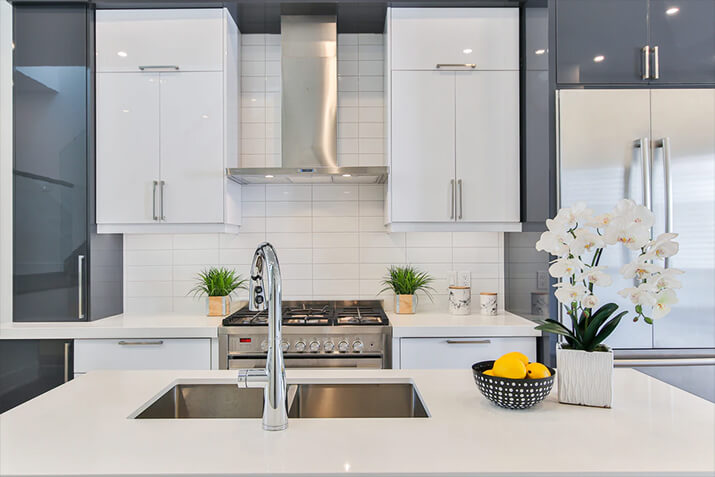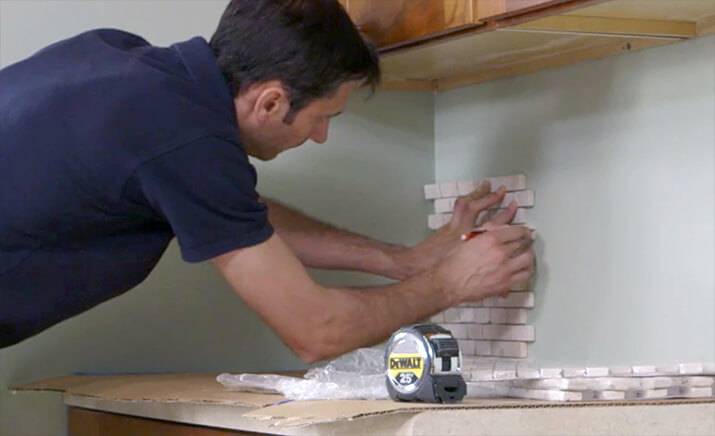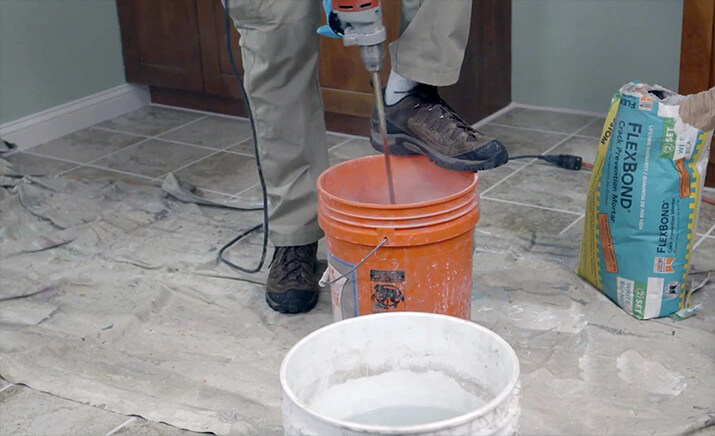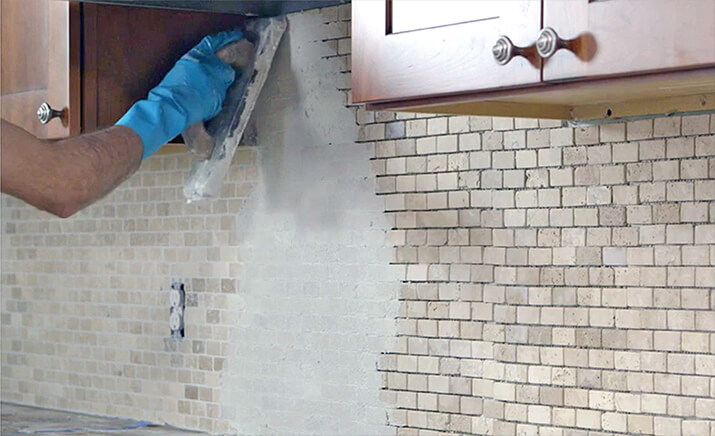Kitchen
How to Install a Kitchen Tile Backsplash in 5 Easy Steps

Sometimes a kitchen needs a bit of a facelift ? and the easiest way to do that is by changing your backsplash tile! But instead of calling in a professional to install a kitchen backsplash, most homeowners can take on this DIY project in as little as a weekend. With only a little time required on your part, you can save money on the installation and quickly elevate the look and feel of your kitchen. Use the following guide to learn how to install a kitchen tile backsplash like a pro.
Step 1: Prepare Your Work Area

Before getting started on your project, you need to first prepare your workspace. While laying tile isn’t the messiest home improvement project, there are still steps you should take to ensure your cabinets, countertops, and flooring aren’t damaged in the process. Because you’ll be working on the area above your counters, you should lay floor protection paper on the countertops to add a layer of protection. Cut the protection paper to the length and width of your counters and secure it down with painter’s tape. Floor protection paper is a great option because it allows you to lay down your tile on it, rearrange them as needed, and make notes for yourself in pencil. Alternatively, you can use cardboard boxes, brown paper papers, or sheet plastic.
Along with protecting your countertops, you’ll want to ensure you’re working with a clean and clear space. If your kitchen appliances are against the area where you’re installing the backsplash tile, you’ll want to move them slightly away from the wall. This includes appliances such as your stove or oven. Additionally, you’ll want to remove any faceplates off of your electrical outlets ? but make sure to shut off the power first.
Once your walls are free of appliances and electrical outlet covers, it’s best to clean the surface of the wall. If there are any holes, divots, or cracks, use spackle and sandpaper to create a smooth backdrop for your kitchen backsplash tile. If needed, use warm water and mild soap to lightly clean off any excess dirt and debris. Getting your walls in tiptop shape before applying the tile increases the strength of the bond ? allowing your tile to last even longer.
Step 2: Arrange Your Backsplash Tile

Now that you’ve properly prepared your work area, it’s time to arrange your kitchen tile backsplash. Choose a starting point where you will build your tile off from. This should be the more viewable area of the wall. Arrange the tile on the wall and once you’ve narrowed down its placement, you can use the protection paper to make note of any tiles that need to be trimmed down to fit properly.
If you need to cut some of your backsplash tiles, the required tool will vary depending on the type of material you’re working with. For porcelain or ceramic backsplash tile, opt for a tile cutter. When working with natural stone tile you will want to use a wet tile saw to avoid damage such as chipping or cracking.
Don’t forget that you will also need to cut your backsplash tile to seamlessly fit around electrical outlets, light fixtures, and kitchen appliances.
Step 3: Create the Mortar

To adhere your tile backsplash to the wall, you’ll need to create the powdered thin-set mortar. Follow the instructions on your specific package, which will guide you through the process of adding the thin-set powder to a bucket of water and thoroughly mixing it. Once the mixture has been combined, allow it to rest for five to 10 minutes. Once the allotted time has passed, give it a final mix. From this point on you are racing against the clock ? most mortar can be used up to four hours before it dries out.
Begin applying the mortar to the wall using a trowel to create a thin layer. To ensure the mortar adheres to the wall, offering ample security for your tile, hold the trowel at a 45-degree angle as you spread it out. Once you have a thin layer applied to the wall, use the notched edge of the trowel to add ridges of extra mortar.
Keep in mind that you should work in seconds of 2-feet at a time. If you spread the mortar out too far, it may dry or form a layer of skin before you can apply the tile to the wall.
Step 4: Adhere the Backsplash

Working in a rhythm, you can begin applying the tiles in your pre-arranged pattern to the wet mortar. Use tile spacers to ensure there is adequate spacing between each tile which will allow for the grout to set the tiles in place.
In most cases, it’s recommended that you begin with the bottom row and work your way up the wall. Firmly press the tiles in place, applying the space, and repeat until all of the backsplash tiles have been attached to the wall. Work your way through each row, periodically stepping back to admire your work at a distance to ensure everything is aligned straight and to your liking.
Step 5: Apply Grout

Once the kitchen tile backsplash has been installed, it’s time to apply the grout to set the tiles in place. Grout comes in a variety of colors, so you have the option to match or contrast your tiles. Most local hardware stores offer pre-mixed grout that simply requires you to use your drill’s mixing attachment and mix the grout until it’s a similar consistency to peanut butter. From there, it’s time to start applying it to the wall because grout dries out extremely quickly!
Lightly wipe down your backsplash with a damp sponge to remove any dust or debris before you begin grouting. Remove the tile spacers from between each tile and begin applying the grout with a rubber float at a 45-degree angle. For an effective application, apply the grout diagonally so the grout fills up the space between tiles. Once the tile spaces have been filled, gently remove any excess grout with the rubber float and allow it to set.
After about ten minutes, lightly rub the tile with a damp sponge to remove any excess grout. During this process, the sponge must be slightly damp ? you don’t want to get the grout wet which can weaken its bond. Once the grout has dried, you can use a cloth to remove any leftover dust and debris from the grout that is remaining on the tiles. Allow the backsplash to set for a few more days to ensure it’s thoroughly dried before applying a grout sealant and reapplying your outlet covers and moving your kitchen appliances back in place.
Ready to get started on your kitchen tile backsplash project? Now that you know how to install kitchen backsplash, check out our comprehensive guide to the most popular kitchen backsplash ideas expected to gain popularity in 2021.
Kitchen Tile Backsplash Installation FAQs
Do you need to have a backsplash in your kitchen?
Although a backsplash does a lot to enhance the look of your kitchen, it also plays an important part in keeping your kitchen clean. A tile backsplash protects your wall from being coated with water, grease, sauce, and other elements that can damage or stain your walls.
Can tile be installed over painted drywall?
Yes, you can apply a kitchen tile backsplash to a variety of materials ? painted or unpainted drywall, plaster, textured walls, or existing tile. However, if your walls are covered in wallpaper or have a glossy surface, you will want to remove this before applying the tile for optimal results.
Do I need to use tile spacers?
Any step-by-step guide for tiling will recommend that you use tile spacers, and for a good reason. Using spacers to keep the optimal distance between the tiles allows for the right amount of grout to set between each tile, ensuring your backsplash is more durable and secure. If your tiles are applied too close together it can cause stress on the tiles if they expand as the temperatures shift.
Should a tile backsplash be installed behind the stove?
Because you will pull your kitchen appliances away from the wall when installing the tile backsplash, you can install the tile behind the stove ? and you should! The stove is one of the messiest areas of the kitchen and grease, steam, and food particles often find their way behind the stove. By installing the backsplash behind the stove, you’ll be able to easily wipe down the tile and keep your kitchen looking spic and span.
![See your dream kitchen in 3D [GET YOUR FREE DESIGN]](https://cdn.kitchencabinetkings.com/blog/wp-content/uploads/see-your-dream-kitchen-in-3d.webp)
![Contractor Discount Program: Offering contractors and builders special volume discounts on all applicable orders [LEARN MORE]](https://cdn.kitchencabinetkings.com/blog/wp-content/uploads/contractor-discount-program.webp)
![Explore our photo gallery [GET INSPIRED]](https://cdn.kitchencabinetkings.com/blog/wp-content/uploads/explore-our-photo-gallery.webp)
![What everyone is saying about KCK [READ REVIEWS]](https://cdn.kitchencabinetkings.com/blog/wp-content/uploads/what-everyone-is-saying-about-kck.webp)
![Get a cabinet sample [SHOP SAMPLES]](https://cdn.kitchencabinetkings.com/blog/wp-content/uploads/get-a-cabinet-sample.webp)
![Pay over time, on your terms with Affirm [LEARN MORE]](https://cdn.kitchencabinetkings.com/blog/wp-content/uploads/pay-over-time-on-your-terms-with-affirm.webp)
Thank you for the tips about tile installation — they were very helpful!
Awesome information! Got real useful tips to consider and will use them as a future reference, thank you!
Excellent post! Very nice and helpful information has been given in this post. Very well written article. Thanks, and keep on sharing 🙂
Great job. I am looking for someone to assist me in the installation of my kitchen backsplash. Can you assist?
Hi Toyin- Unfortunately, we cannot help with any type of backsplash installation.
Best,
Andrew